tire pressure PONTIAC GRAND-PRIX 1993 Owners Manual
[x] Cancel search | Manufacturer: PONTIAC, Model Year: 1993, Model line: GRAND-PRIX, Model: PONTIAC GRAND-PRIX 1993Pages: 338, PDF Size: 17.3 MB
Page 149 of 338
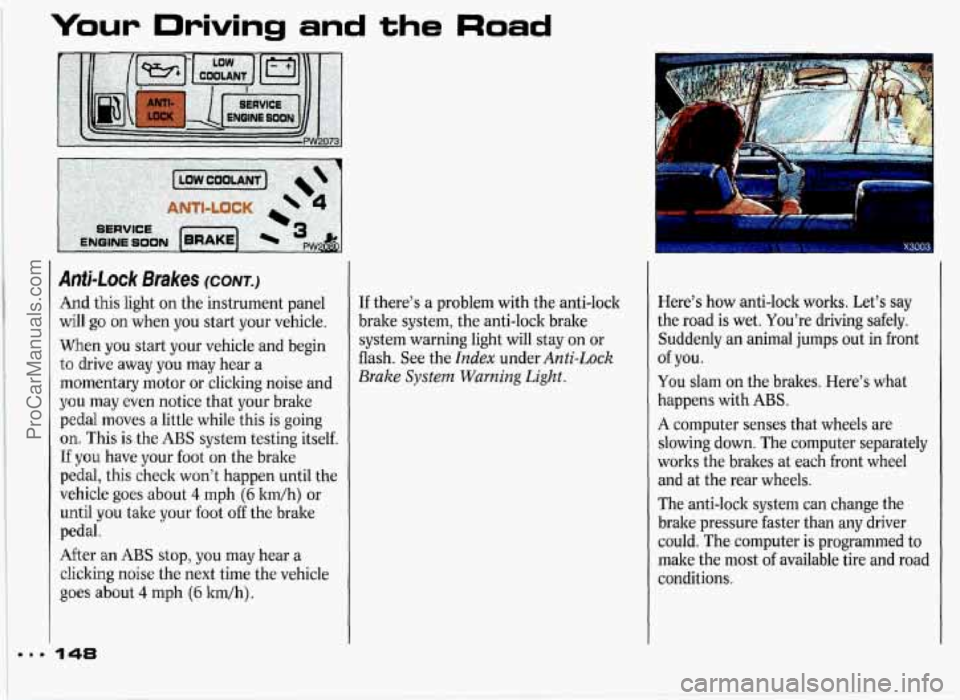
ma.
Your Driving and the Road
Anti-lock Brakes (CONT.)
And this light on the instrument panel
will
go on when you start your vehicle.
When you start your vehicle and begin
to drive away you may hear a
momentary motor or clicking noise and
you may even notice that your brake
pedal moves a little while this is going
on. This is the ABS system testing itself.
If you have your foot on the brake
pedal, this check won't happen until the
vehicle goes about
4 mph (6 ltm/h) or
until you take your foot off the brake
pedal.
After
an ABS stop, you may hear a
clicking noise the next time the vehicle
goes about 4 mph (6 ltdh).
148
If there's a problem with the anti-lock
brake system, the anti-lock brake
system warning light will stay on or
flash. See the
Index under Anti-Lock
Brake
System Warning Light.
Here's how anti-lock works. Let's say
the road is wet. You're driving safely.
Suddenly an animal jumps out in front
You slam on the brakes. Here's what
happens with
ABS.
A computer senses that wheels are
slowing down. The computer separately
works the brakes at each front wheel
and at the rear wheels.
The anti-lock system can change the
brake pressure faster than any driver
could. The computer is programmed to
make the most
of available tire and road
conditions.
of you.
ProCarManuals.com
Page 158 of 338
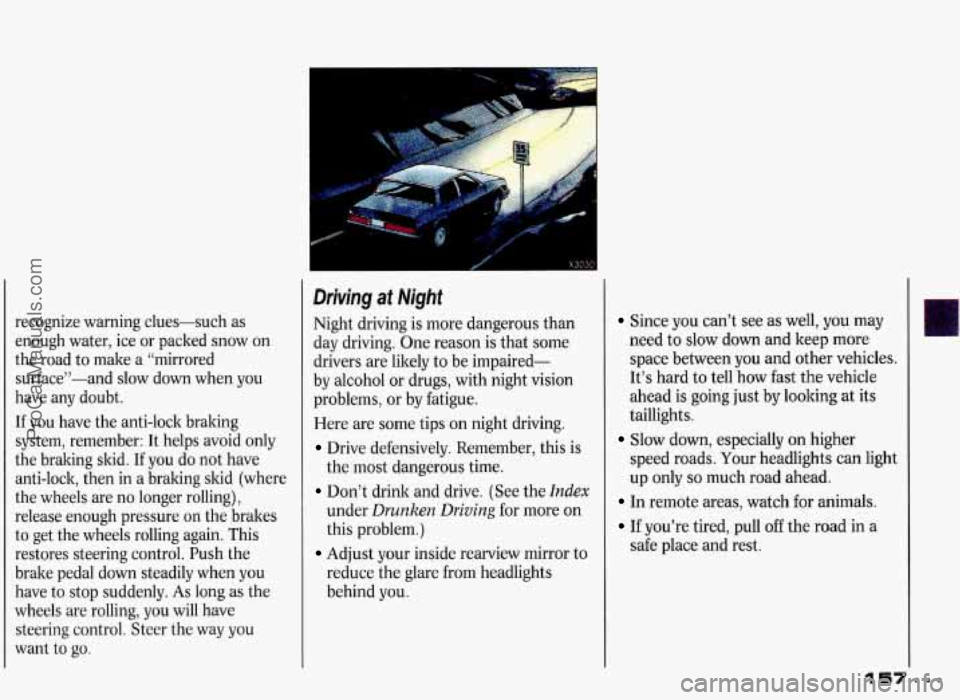
recognize warning clues-such as
enough water, ice or packed snow
on
the road to make a “mirrored
surface”-and slow down when you
have any doubt.
If you have the anti-lock braking
system, remember: It helps avoid only
the braking skid.
If you do not have
anti-lock, then in a braking skid (where
the wheels are no longer rolling),
release enough pressure on the brakes
to get the wheels rolling again. This
restores steering control. Push the
brake pedal down steadily when you
have to stop suddenly. As long as the
wheels are rolling, you will have steering control. Steer the way you
want to go.
Driving at Night
Night driving is more dangerous than
day driving. One reason is that some
drivers are likely to be impaired-
by alcohol or drugs, with night vision
problems, or by fatigue.
Here are some tips on night driving.
Drive defensively. Remember, this is
the most dangerous time.
Don’t drink and drive. (See the Index
under Drunken Driving for more on
this problem.)
Adjust your inside rearview mirror to
reduce the glare hom headlights
behind you.
II
Since you can’t see as well, you may
need to slow down and keep more
space between you and other vehicles.
It’s hard to tell how fast the vehicle
ahead is going just by looking at its
taillights.
speed roads. Your headlights
can light
up only
so much road ahead.
Slow down, especially on higher
In remote areas, watch for animals.
If you’re tired, pull off the road in a
safe place and rest.
I
ProCarManuals.com
Page 162 of 338
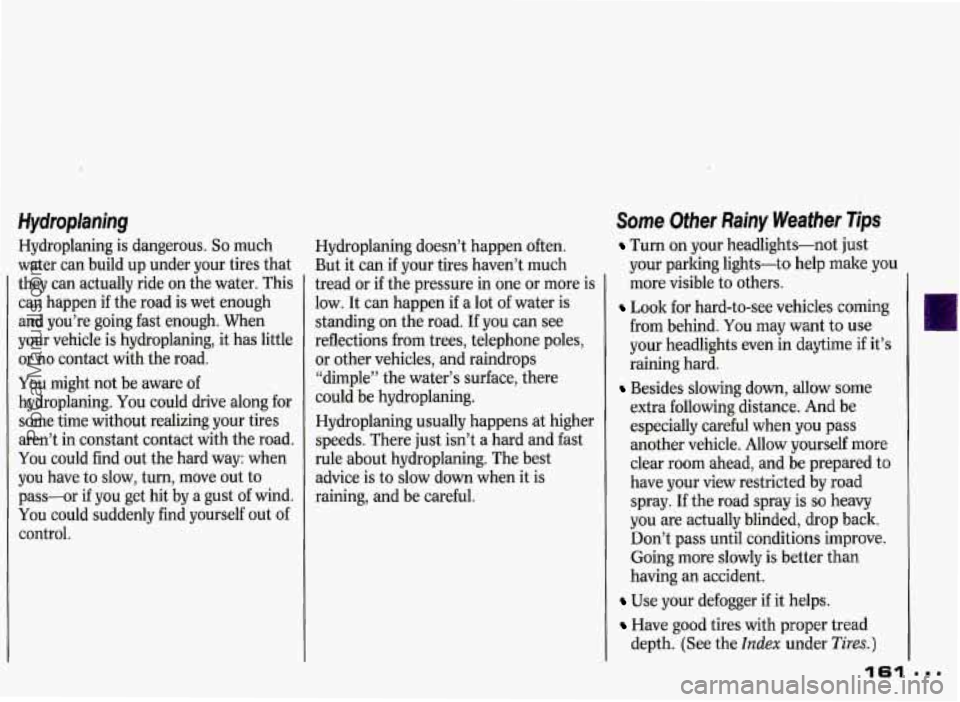
Hydroplaning
Hydroplaning is dangerous. So much
water can build up under your tires that
they can actually ride on the water. This
can happen if the road is wet enough
and you’re going fast enough. When
your vehicle is hydroplaning, it has little
or no contact with the road.
You might not be aware of
hydroplaning. You could drive along for
some time without realizing your tires
aren’t in constant contact with the road.
You could find out the hard way: when
you have to slow, turn, move out to
pass-or
if you get hit by a gust of wind.
You could suddenly find yourself out of
control. Hydroplaning doesn’t
happen often.
But it can if your tires haven’t much
tread or if the pressure in one or more is
low. It can happen if a lot of water is
standing on the road. If you can see
reflections from trees, telephone poles,
or other vehicles, and raindrops
“dimple” the water’s surface, there
could be hydroplaning.
Hydroplaning usually happens at higher
speeds. There just isn’t a hard and fast
rule about hydroplaning. The best
advice is to slow down when it is
raining, and be careful.
Some Other Rainy Weather Tips
Turn on your headlights-not just
your parking lights-to help make you
more visible to others.
Look for hard-to-see vehicles coming
from behind.
You may want to use
your headlights even in daytime if it’s
raining hard.
Besides slowing down, allow some
extra following distance.
And be
especially careful when you pass
another vehicle. Allow yourself more
clear room ahead, and be prepared
to
have your view restricted by road
spray. If the road spray is
so heavy
you are actually blinded, drop back.
Don’t pass until conditions improve.
Going more slowly is better than
having an accident.
Use your defogger if it helps.
Have good tires with proper tread
depth. (See the
Index under Tires.)
161 I
ProCarManuals.com
Page 167 of 338
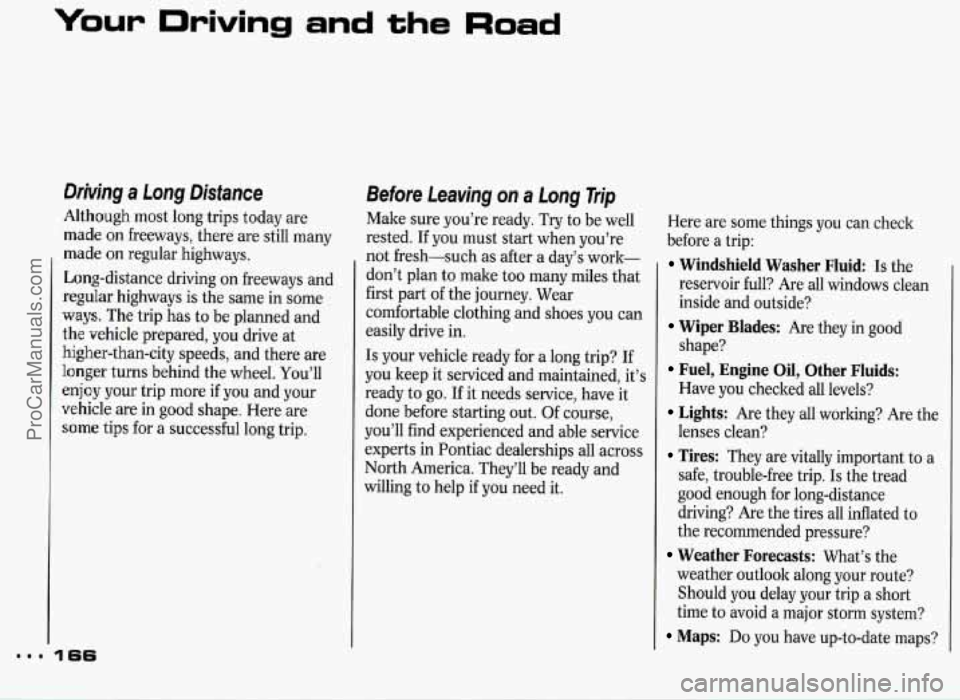
Your Driving and the Road
Drkjng a Long Distance
Although most long trips today are
made on freeways, there are still many
made
on regular highways.
Long-distance driving on freeways and
reguIar highways is the same in some
ways. The trip has to be planned and
the vehicle prepared, you drive at
higher-than-city speeds, and there are
longer turns behind the wheel. You’ll
enjoy your trip more if you and your
vehicle are in good shape. Here are
some tips for a successful long trip.
Before Leaving on a Long Trip
Make sure you’re ready. Try to be well
rested. If you must start when you’re
not fresh-such as after a day’s work-
don’t plan to make too many miles that
first part of the journey. Wear
comfortable clothing and shoes you can
easily drive in.
Is your vehicle ready for a long trip? If
you keep it serviced and maintained, it’s
ready to go. If it needs service, have it
done before starting out. Of course,
you’ll find experienced and able service
experts in Pontiac dealerships all across
North America. They’ll be ready and
willing to help
if you need it. Here
are some things you can check
before a trip:
Windshield Washer Fluid Is the
reservoir full? Are all windows clean
inside and outside?
shape?
Have you checked all levels?
lenses clean? safe, trouble-free trip.
Is the tread
good enough for long-distance
driving? Are the tires all inflated to
the recommended pressure?
weather outlook along your route?
Should
you delay your trip a short
time to avoid a major storm system?
Maps: Do you have up-to-date maps?
Wiper Blades: Are they in good
Fuel, Engine Oil, Other Fluids:
Lights: Are they all working? Are the
Tires: They are vitally important to a
Weather Forecasts: What’s the
ProCarManuals.com
Page 172 of 338
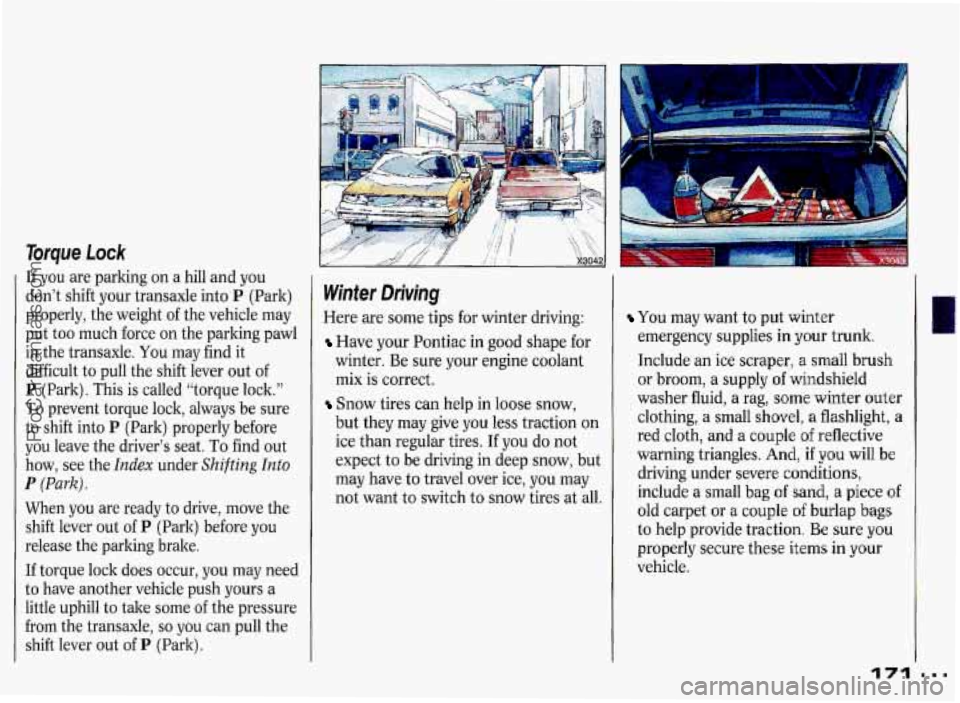
Torque Lock
If you are parking on a hill and you
don’t shift your transaxle into P (Park)
properly, the weight of the vehicle may
put too much force on the parking pawl
in the transaxle.
You may find it
difficult to pull the shift lever out of
P (Park). This is called “torque lock.”
To prevent torque lock, always be sure
to shift into
P (Park) properly before
you leave the driver’s seat. To find out
how, see the
lndex under Shifting Into
P (Park).
When you are ready to drive, move the
shift lever out
of P (Park) before you
release the parking brake.
If torque lock does occur, you may need
to have another vehicle push yours
a
little uphill to take some of the pressure
from the transaxle,
so you can pull the
shift lever out
of P (Park).
Winter Driving
Here are some tips for winter driving:
Have your Pontiac in good shape for
winter. Be sure your engine coolant
mix is correct.
Snow tires can help in loose snow,
but they may give
you less traction on
ice than regular tires. If you do not
expect to be driving in deep snow, but
may have to travel over ice,
you may
not want to switch to snow tires at all.
.. “I
. ..
You may want to put winter
emergency supplies
in your trunk.
Include an ice scraper, a small brush
or broom, a supply of windshield
washer fluid, a rag,
some winter outer
clothing, a small shovel,
a flashlight, a
red cloth, and a couple of reflective
warning triangles.
And, if you will be
driving under severe conditions,
include
a small bag of sand, a piece of
old carpet or a couple of burlap bags
to help provide traction. Be sure you
properly secure these items in your
vehicle.
171
ProCarManuals.com
Page 180 of 338
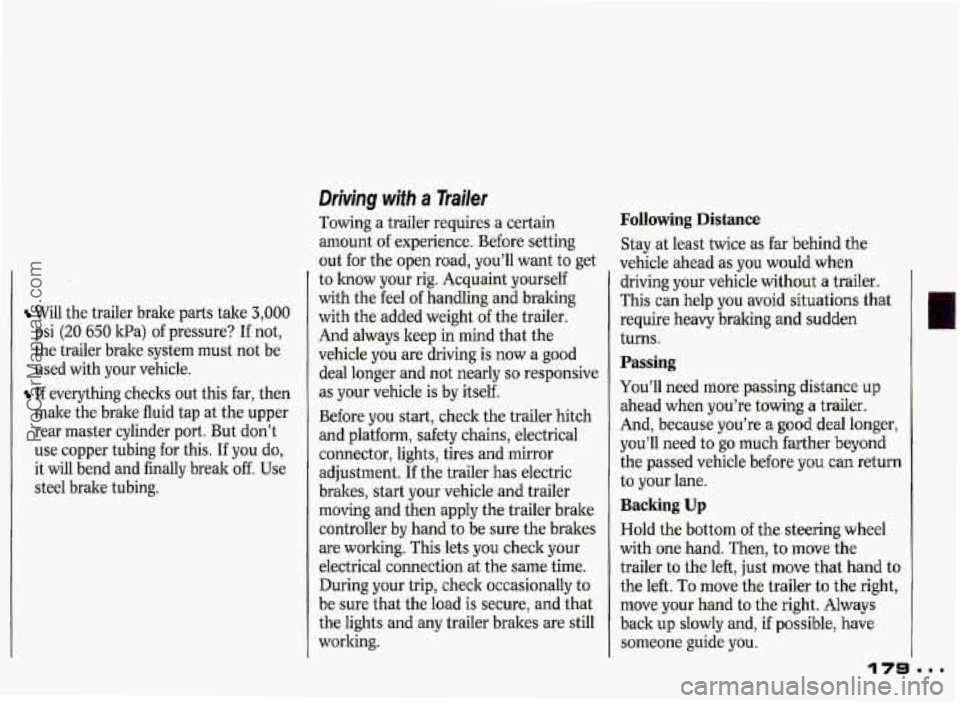
Will the trailer brake parts take 3,000
psi (20 650 1tPa) of pressure? If not,
the trailer brake system must not be
used with your vehicle.
If everything checks out this far, then
make the brake fluid tap at the upper
rear master cylinder port. But don’t
use copper tubing for this. If you do,
it will bend and finally break
off. Use
steel brake tubing.
Driving with a Trailer
Towing a trailer requires a certain
amount of experience. Before setting
out for the open road, you’ll want to get
to know your rig. Acquaint yourself
with the feel of handling and braking
with the added weight of the trailer.
And always keep in mind that the
vehicle you are driving is now a good
deal longer and not nearly
so responsive
as your vehicle is by itself.
Before you start, check the trailer hitch
and platform, safety chains, electrical
connector, lights, tires and mirror
adjustment. If the trailer has electric
brakes, start your vehicle and trailer
moving and then apply the trailer brake
controller by hand to be sure the brakes
are working. This lets
you check your
electrical connection at the same time.
During your trip, check occasionally to
be sure that the load is secure, and that
the lights and any trailer brakes are still
working.
Following Distance
Stay at least twice as far behind the
vehicle ahead as you would when
driving your vehicle without
a trailer.
This can help you avoid situations that
require heavy braking and sudden
turns.
Passing
You’ll need more passing distance up
ahead when you’re towing a trailer.
And, because you’re a
good deal longer,
you’ll need to
go much farther beyond
the passed vehicle before you can return
to your lane.
Backing Up
Hold the bottom of the steering wheel
with one hand. Then, to move
the
trailer to the left, just move that hand to
the left.
To move the trailer to the right,
move your hand to the right. Always
back up slowly and, if possible, have
someone guide you.
ProCarManuals.com
Page 208 of 338
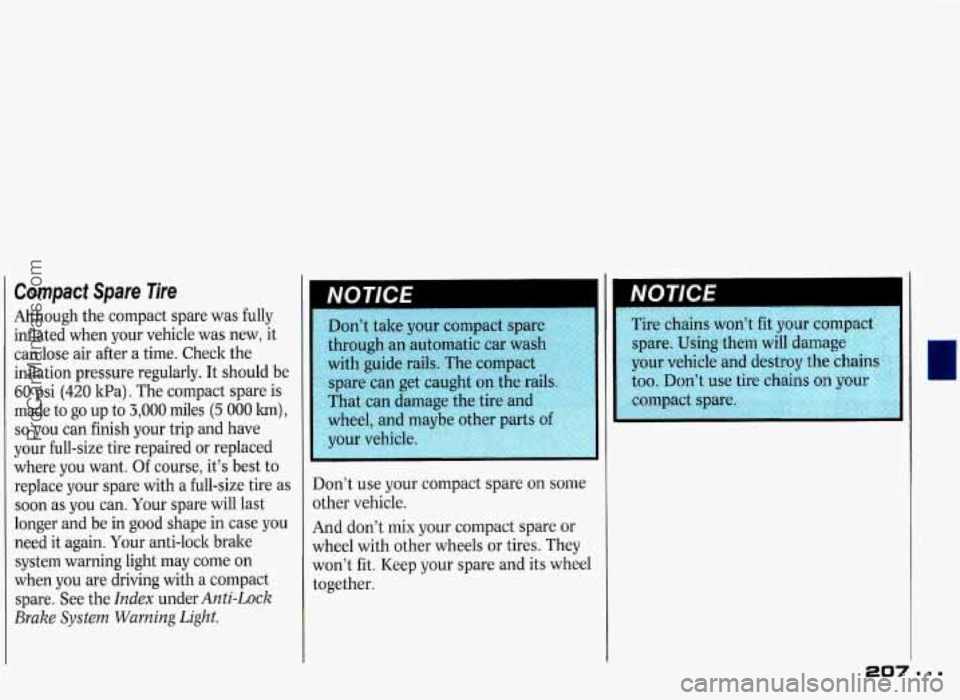
Compact Spare Tire
Although the compact spare was fully
inflated when your vehicle was new, it
can lose air after a time. Check the
inflation pressure regularly. It should be
60 psi (420 1tPa). The compact spare is
made to go up to 3,000 miles (5 000 lm),
so you can finish your trip and have
your full-size tire repaired or replaced
where you want. Of course, it’s best to
replace your spare with a full-size tire as
soon as you can. Your spare will last
longer and be in good shape in case you
need it again. Your anti-lock brake
system warning light may come on
when
you are driving with a compact
spare. See the
Index under Anti-Lock
Brake System Warning Light.
take your compact spare
through an automatic car wash
with guide rails. The compac
spare can get caught
on the r
That can damage the tire and
wheel, and ma
your vehicle
Don’t use your compact spare on some
other vehicle.
And don’t mix your compact spare or
wheel with other wheels or tires. They
won’t fit. Keep your spare and its wheel
together.
NU I IL‘t
Tire chains won’t fit your compact
spare. Using
them will damage
your vehicle and destroy the chains
too. Don’t use tire chai
ProCarManuals.com
Page 253 of 338
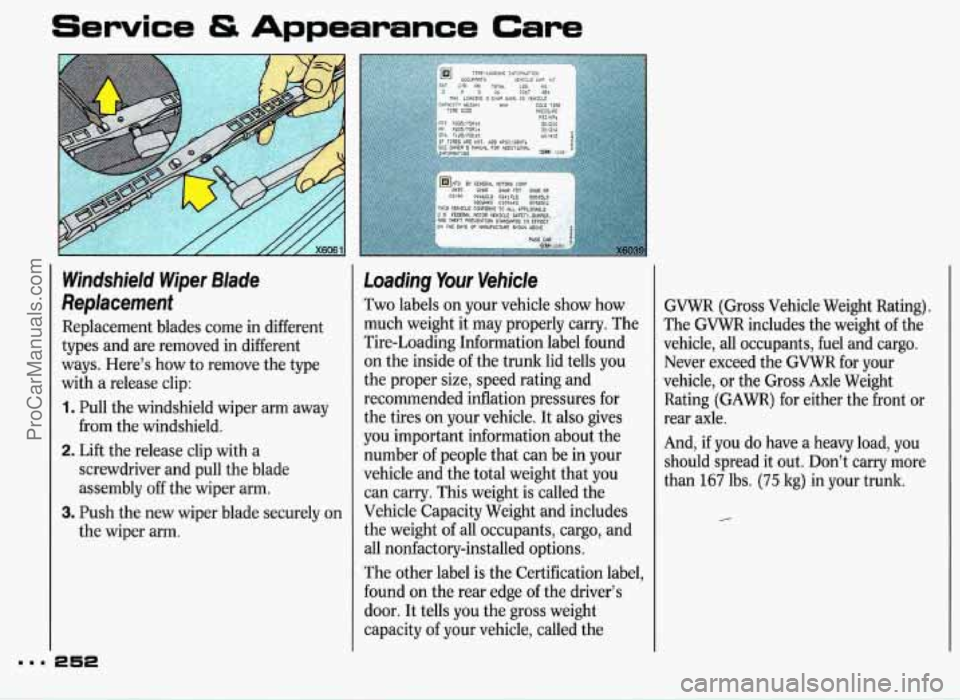
aam
Service & Appearance Care
Windshield Wiper Blade
Replacement
Replacement blades come in different
types and are removed in different
ways. Here’s how to remove the type
with
a release clip:
1. Pull the windshield wiper arm away
2. Lift the release clip with a
from the
windshield.
screwdriver and pull the blade
assembly off the wiper arm.
the wiper arm.
3. Push the new wiper blade securely on
252
Loading Your Vehicle
Two labels on your vehicle show how
much weight it may properly carry. The
Tire-Loading Information label found
on the inside of the trunk lid tells you
the proper size, speed rating and
recommended inflation pressures for
the tires on your vehicle. It also gives
you important information about the
number of people that can be in your
vehicle and the total weight that you
can carry. This weight is called the
Vehicle Capacity Weight and includes
the weight of all occupants, cargo, and
all nonfactory-installed options.
The other label is the Certification label,
found on the rear edge of the driver’s
door. It tells you the gross weight
capacity of your vehicle, called the GVWR
(Gross Vehicle Weight Rating).
The GVWR includes the weight of the
vehicle, all occupants, fuel and cargo.
Never exceed the GVWR for your
vehicle, or the Gross Axle Weight
Rating (GAWR) for either the front or
rear axle.
And,
if you do have a heavy load, you
should spread it out. Don’t carry more
than
167 lbs. (75 kg) in your trunk.
ProCarManuals.com
Page 255 of 338
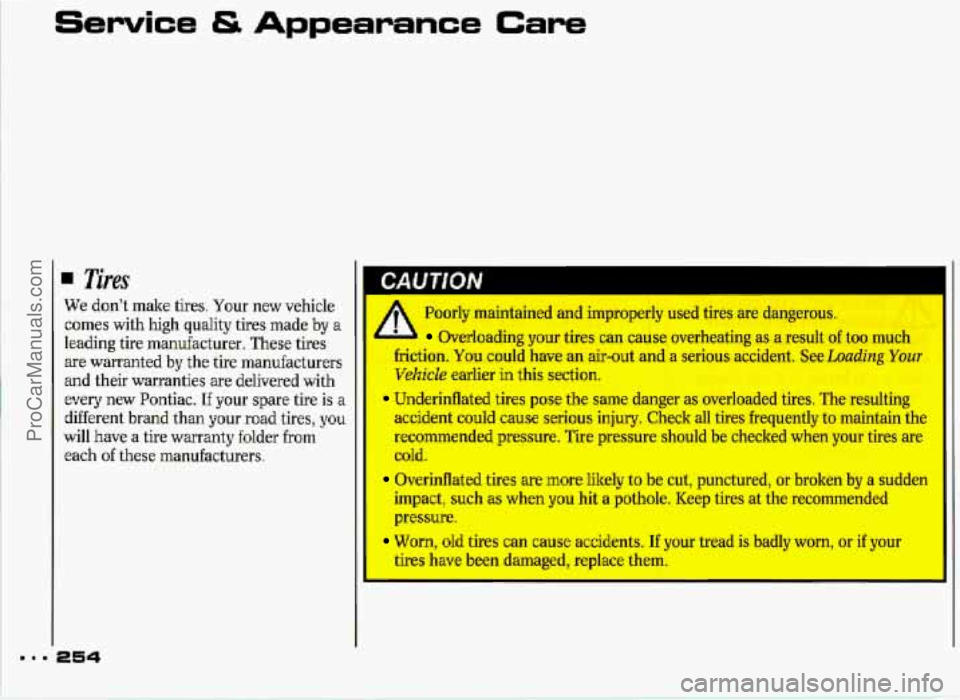
Service & Appearance Care
4 Tires
We don't make tires. Yo'ur new vehicle
comes with
high quality tires made by a
leading tire manufacturer. These tires
are warranted
by the tire manufacturers
and their warranties are delivered with
every
new Pontiac. If your spare tire is a
different brand than your road tires, you
will have a tire warranty folder from
each of these manufacturers.
254
1 A, Poorly maintained armd improperly used tires are dangerous.
b Overloading your tires can cause overheating as a result of too much
friction. YOU could have an &-out and a serious accident. See Loading Your
Vehicle earlier in this section.
accident
could cause serious injury. Check all tires frequently to maintain the
recommended
pressure. Tire pressure should be checked when your tires are
cold.
Overinflated tires are more Likely to be cut, punctured, or broken by a sudden
impact, such as when you hit a pothole. Keep tires at the recommended
pressure.
Worn, old tires can cause accidents. If your tread is badly worn, or if your
tires have been damaged, replace them.
Underinflated tires pose the same danger as overloaded tires. The resulting
ProCarManuals.com
Page 256 of 338
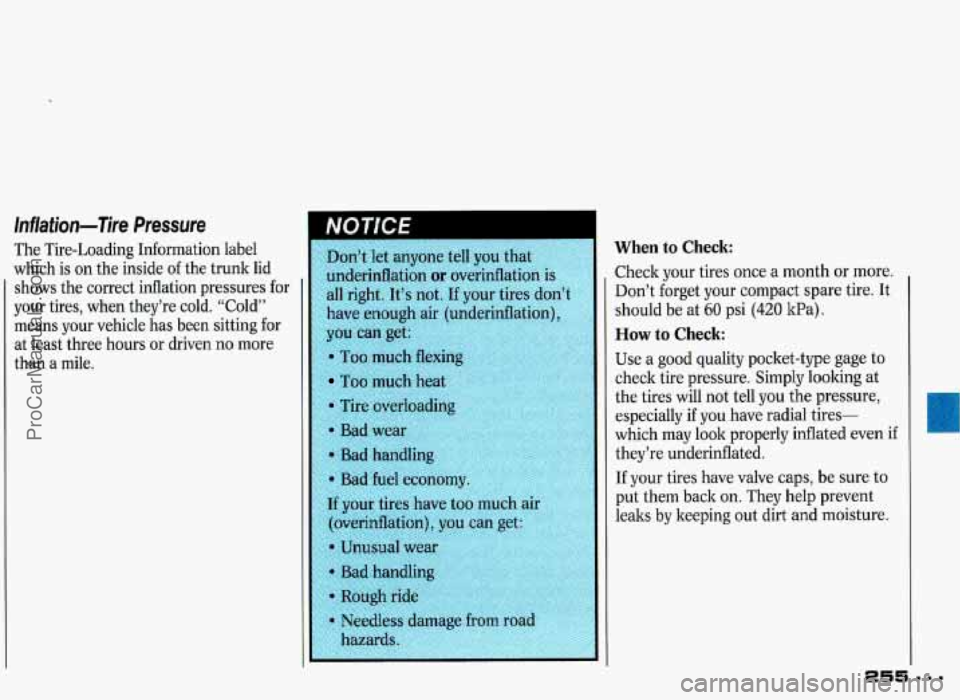
Inflation-Tire Pressure
The Tire-Loading Information label
which is on the inside of the trunk lid
shows the correct inflation pressures for
your tires, when they’re cold. “Cold”
means your vehicle has been sitting for
at least three hours or driven
no more
than a mile. Don’t let anyone
tell you th
underinflation
or overinflati
all right. It’s not.
If your tires d
have enough air (underinflation
Too much heat
If your tires have too much air
When to Check:
Check your tires once a month or more.
Don’t forget your compact spare tire. It
should be at
60 psi (420 ItPa).
How to Check:
Use a good quality pocket-type gage to
check tire pressure. Simply loolting at
the tires will not tell you the pressure,
especially if you have radial tires-
which may
look properly inflated even if
they’re underinflated.
If your tires have valve caps, be sure to
put them back on. They help prevent
leaks by keeping out dirt
and moisture.
ProCarManuals.com